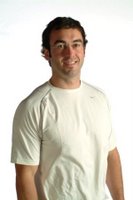
This is from Alwyn Cosgrove's latest newsletter
Alwyn recently put together a book called Strength Coach Interrogations ...and he interviewed me along with 20 other strength coaches. Lots of great info in it...
Here's one of the q's from my interview...
AC: Can you describe a typical training session consist of for your clients?
CB:
My Turbulence Training system can be adapted for any goal and any experience level.I call the warm-up, Athletic Movement Training, and others might use the term "dynamic warmup" or "dynamic flexibility".
We use a general bodyweight warm-up to start, always trying to incorporate as much of the body as possible into each exercise. So for example, we would do a circuit of bodyweight prisoner squats (to include the upper back muscles), some type of pushing movement (pushups - modified to the trainee's level of difficulty), and some type of pulling movement (focusing on shoulder blade retraction).
All exercises are "core exercises" - as we brace the abs and activate all of the core muscles while doing all exercises in the entire workout.
For an athlete, the number of exercises in the Athletic Movement Warm-up will increase in comparison to a client looking for fat loss or muscle gain, and will even differ depending on the amount of speed and agility training to be done in the athletes workout.
Then we work on actively increasing the range of motion for any problem spots - and this is individual to the client. So it depends on what we have learned from their assessment and previous training sessions. If any work needs to be done on the foam roller, we do it now. Same with any exercises that are required for this individual in terms of injury prevention (i.e. rotator cuff exercises or other small muscles - again, determined through assessment and from previous workouts).
Next, it is onto the strength training, using the TT principles. Efficient and effective exercises are paired with other non-competing efficient and effective exercises in supersets. The repetition range, number of sets per superset, and rest intervals will vary depending on the clients goals but all are picked to create the appropriate level and type of turbulence in the person's body to stimulate the correct physical change.
I prefer to stick with a lower repetition range than that normally found intraditional bodybuilding programs. Therefore, I find it very easy to make a client stronger. All you need to do is stick to the basics. Metabolic conditioning and/or fat loss intervals will follow the strength training. We will complete the session with stretching for the tight muscles only.
Another consideration - we won't apply aggressive stretching to a muscle that was trained hard during this session, or a muscle that is to be trained hard on the following day. We will only do light stretching for that particular muscle group.
CB















No comments:
Post a Comment